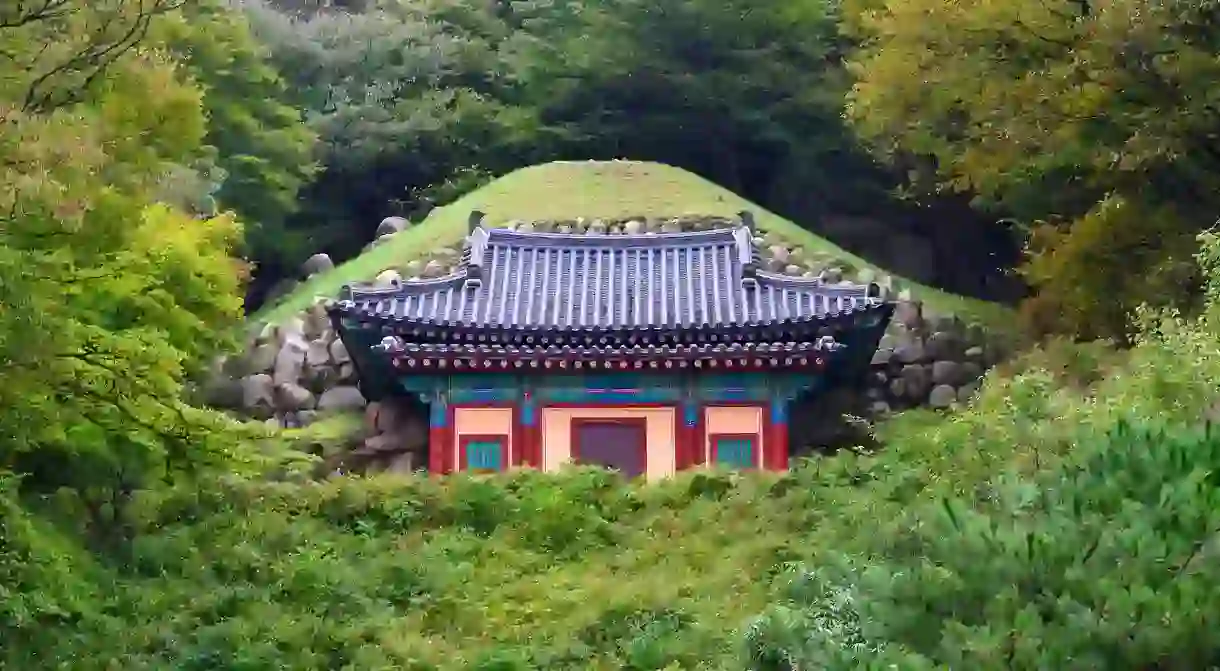The Must-See Temples in South Korea

South Korea masterfully balances rapid urbanisation with revered cultural traditions. Its steel skyscrapers and bustling cities co-exist harmoniously with the calming beauty of more than 900 traditional Buddhist temples – centuries-old architecture tucked among the numerous mountains in the country. Korea has a 1,700-year-old Buddhist history, but, regardless of your religion, these tranquil, spiritual temples will give you a quiet refuge in which to meditate or rediscover peace of mind.
Gagwonsa Temple
Buddhist Temple
Visitors flock to this temple in the city of Cheonan to pay homage to its bronze sitting-Buddha statue. And no wonder: it weighs 60 tons and towers skyscraper-like at the top of 203 steps! You’ll witness devotees kneeling on a platform in front of the mammoth apparition, one of the biggest sitting Buddhas in Asia, or circling it while praying. Impressive as it is, do also take time to explore the rest of the temple, dedicated to the hopeful, eventual reunification of North and South Korea.
Bongeunsa Temple
Buddhist Temple

It’s most famous for the PSY K-Pop hit and a glossy shopping scene, but Seoul’s Gangnam district is also home to one of the most popular temples in Korea: Bongeunsa. Tucked in among the high-rises of Samseong-dong, north of the landmark COEX building, it’s visited by about 10,000 people every day. They come for its 3,479 Buddhist scriptures and, in some cases, the chance to stay here overnight. Sign up for a 48-hour programme, and you’ll get to live like a monk, with tea ceremonies, Buddhist services and Zen meditation.
Haedong Yonggung Temple
Shrine

Tapsa Temple
Buddhist Temple

It might not be that large, but Tapsa has an otherworldly setting – flanked by cliffs and framed by mountain peaks – that makes it essential viewing on any South Korea tour. A scenic hike gets you here – through the Maisan (‘horse ear’) mountains in the North Jeolla Province – before, suddenly, dozens of unique stone pagodas emerge. Built without mortar, by a scholar in the late 1800s, they have, miraculously, survived the strong local winds to this day. It’s a one-in-a-million spiritual experience, so don’t forget to pack your camera.
Sudeoksa Temple
Buddhist Temple
It’s not that often you get the chance to visit a bonafide national treasure, but the main hall of this 1,500-year-old temple in the Deok Sung Shan Mountains is designated as one. A head temple of the Jogye Order of Korean Buddhism, it is a crucial spot in terms of the country’s Buddhist history and a great place to learn more about it. Sign up to a temple stay, and you’ll get to taste the lifestyle of a monk; rise to bells at 3am, start the day with chanting, and enjoy simple pleasures such as meditation hikes and hot spring baths.
Bulguksa Temple
Buddhist Temple
Set off a cliff-hugging hairpin road in South Korea’s cultural centre of Gyeongju, Bulguksa is perhaps the most celebrated temple in the entire country. One visit to this UNESCO World Heritage Site, and you’ll understand why. There’s the dramatic setting for starters – but you’ll also find a rambling series of ornately painted buildings, colourful lanterns and elegant mature trees that feel deliciously atmospheric (especially in autumn, when the foliage turns brilliant red). After exploring the main site, follow the winding road further up the mountain to the ancient Seokguram Grotto.
Jogyesa Temple
Buddhist Temple

Most of the finest temples in South Korea are set in mountainous landscapes, but Jogyesa is a notable exception – it’s surrounded by the skyscrapers of Seoul. Walking distance from two of the most impressive palaces in the capital, Gyeongbokgung and Changdeokgung, it is painted in some of the same brilliant hues – jade, red and gold – and decorated with intricate frescoes. With a pair of 500-year-old pine trees flanking the temple, this place feels like a timeless, tranquil pocket untouched by the glitzy, modern surrounds.
Bomunsa Temple
Buddhist Temple
Seongmodo Island, with its beach, hiking trails and bikes to hire, is a different world from the busy mainland cities that typify a South Korea itinerary. It’s also a perfect day trip from Seoul. One of the key must-sees on the island is Bomunsa, perched on a mountain, overlooking the water. Believed to date back to 635CE, it is a temple with serious history – and photogenic looks, too; think dozens of statues, knobbly trees and stone carvings, not to mention those sea views.
Tongdosa Temple
Buddhist Temple

You can easily spend half a day exploring Tongdosa, one of South Korea’s ‘jewel temples’ – that is, the most important Buddhist temples in the country. The grandest temple complex in South Korea has over 50 buildings, plus courtyards, stupas and a half-moon bridge. Notably, it doesn’t have any outdoor Buddha statues, which is why it’s sometimes referred to as “the temple without a Buddha”. Don’t miss the museum on the temple grounds, which shows off impressive Buddhist artwork.
Guinsa Temple
Buddhist Temple
It’s one of the newer temples South Korea has to offer – founded as recently as 1945 – but a visit to Guinsa is worthwhile for both its setting and its scale. Cloaked in the greenery of the Sobaek Mountains, it’s the administrative centre of more than 140 other temples, and there is sufficient accommodation for as many as 10,000 monks to live here at any given time. Because of the large-scale farming operation attached, visitors get served up a free vegetarian meal – breakfast, lunch or dinner, depending on when you arrive.
Alexis K. Barnes contributed additional reporting to this article.













